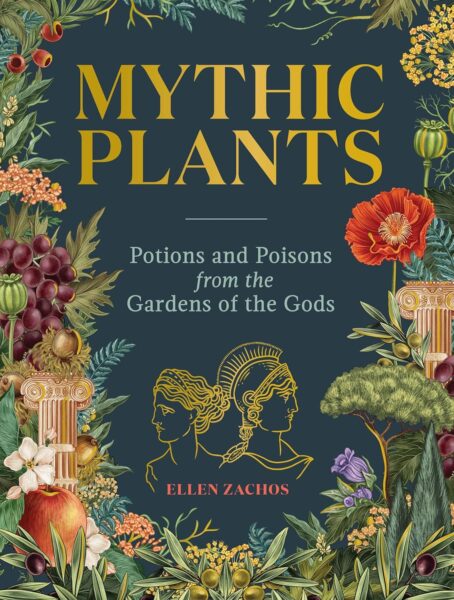with Ellen Zachos
 This week, Joanne welcomes Ellen Zachos, author of 11 books on plants, including her latest, Mythic Plants: Potions and Poisons from the Gardens of the Gods.
This week, Joanne welcomes Ellen Zachos, author of 11 books on plants, including her latest, Mythic Plants: Potions and Poisons from the Gardens of the Gods.
About Ellen
A Harvard graduate, Ellen’s first career was on Broadway (Les Miz), but the gift of a peace lily on opening night opened her eyes to the wonderful world of plants. Ellen taught at the New York Botanical Garden for many years and also served as Coordinator of the Gardening Department in Continuing Ed, before moving to Santa Fe, NM. She was named a Great American Gardener by the Epcot Flower and Garden Festival. Her 11th book, Mythic Plants: Potions & Poisons from the Gardens of the Gods, was published this year.
Tune in to hear more about Ellen Zachos and her latest book, Mythic Plants.
Inspiration & Research
- Grew from Ellen’s Greek heritage and lifelong love of mythology and plants.
- Greek mythology felt personally significant; she wasn’t drawn to Norse or Indian myths.
- Extensive research across historical texts; citations couldn’t fit in the print book, but are available online.
Plant Stories & Mythology Connections
- Nepenthe (Poppy):
- In Homer’s Odyssey, Helen of Troy prepared Nepenthe—an “anti-sorrow” drink of wine and opium poppy.
- Calmed grief temporarily. Linnaeus later named the tropical pitcher plant Nepenthes after this myth, believing its beauty could lift sorrow.
- In Homer’s Odyssey, Helen of Troy prepared Nepenthe—an “anti-sorrow” drink of wine and opium poppy.
- Moly (Snowdrop):
- Hermes gave Odysseus “Moly” to protect him from Circe’s spells.
- Described as a plant with black roots and white flowers—likely the snowdrop (Galanthus).
- Contains galantamine, which counters hallucinations—aligning with the myth’s antidote effect.
- Modern research explores galantamine for Alzheimer’s treatment.
- Hermes gave Odysseus “Moly” to protect him from Circe’s spells.
- Fig:
- Valued food in ancient Greece, consumed fresh or dried before refrigeration existed.
- Special laws governed fig harvesting; penalties for theft were severe.
- Ancient figs required complex pollination (caprification).
- Some myths surrounding figs are notably “saucy.”
- Valued food in ancient Greece, consumed fresh or dried before refrigeration existed.
- Pine Tree:
- Associated with violent origin myths, but also practical uses.
- Pine nuts were a staple food; pine resin sealed wine vessels, the origin of Retsina wine.
- Modern Retsina has a milder pine flavour, enjoyed especially in Greek summer settings.
- Associated with violent origin myths, but also practical uses.
- Aconitum (Monkshood):
- Misunderstood as poisonous to touch—false. Dangerous only if ingested.
- Blooms beautifully when few others do; it is resistant to deer and rabbits.
- Ellen wishes for a “Plant Mythbusters” show to debunk misinformation about plant toxicity.
- Misunderstood as poisonous to touch—false. Dangerous only if ingested.
- Daffodil (Narcissus):
- Linked to the myth of Narcissus falling in love with his reflection.
- Also central to the Persephone story, Zeus created a daffodil to lure her before Hades abducted her.
- Explains the origin of winter and spring cycles through Demeter’s grief and renewal.
- Linked to the myth of Narcissus falling in love with his reflection.
Themes & Insights
- Plants in Greek mythology were deeply symbolic, medicinal, and magical.
- Many ancient uses align with modern scientific knowledge.
- The book groups plants thematically into short, easy-to-read chapters, ideal for bedtime or book clubs.
- Appeals to gardeners, historians, herbalists, and mythology enthusiasts.
Ellen’s Life & Work Today
- Now based in Santa Fe with a small, fully edible garden.
- Enjoys discovering new drought-tolerant plants in a vastly different climate.
- Former rooftop gardener in New York City; designed and maintained terrace gardens.
- Also teaches and speaks across the U.S.—including the upcoming Herb Society of America Conference in Texas (April).
- Other popular books: How to Forage for Wild Foods Without Dying, Backyard Foraging, The Wildcrafted Cocktail, The Forager’s Pantry.
- Advocates for safe, informed foraging and appreciation of wild edibles.
- Mythic Plants features beautiful botanical illustrations by Lisel Ashlock.
Mythic Plants makes a great gift and is available on Amazon!
Find Ellen Zachos on Instagram.
Resources Mentioned in the Show:
Down the Garden Path: A Step-By-Step Guide to Your Ontario Garden
Are you a landscape or gardening expert?
We’d love to have you on the show! Click here to learn more.
Find Down the Garden Path on Instagram, Facebook, and YouTube: @downthegardenpathpodcast.
Down the Garden Path Podcast
On Down The Garden Path, professional landscape designer Joanne Shaw discusses down-to-earth tips and advice for your plants, gardens and landscapes.
As the owner of Down2Earth Landscape Design, Joanne Shaw has been designing beautiful gardens for homeowners east of Toronto for over a decade. She does her best to bring you interesting, relevant and useful topics to help you keep your garden as low-maintenance as possible.
 In Down the Garden Path: A Step-By-Step Guide to Your Ontario Garden, Joanne and fellow landscape designer Matthew Dressing distill their horticultural and design expertise and their combined experiences in helping others create and maintain thriving gardens into one easy-to-read monthly reference guide. Get your copy today on Amazon.
In Down the Garden Path: A Step-By-Step Guide to Your Ontario Garden, Joanne and fellow landscape designer Matthew Dressing distill their horticultural and design expertise and their combined experiences in helping others create and maintain thriving gardens into one easy-to-read monthly reference guide. Get your copy today on Amazon.
Don’t forget to check out Down the Garden Path on your favourite podcast app and subscribe! You can now catch the podcast on YouTube.



